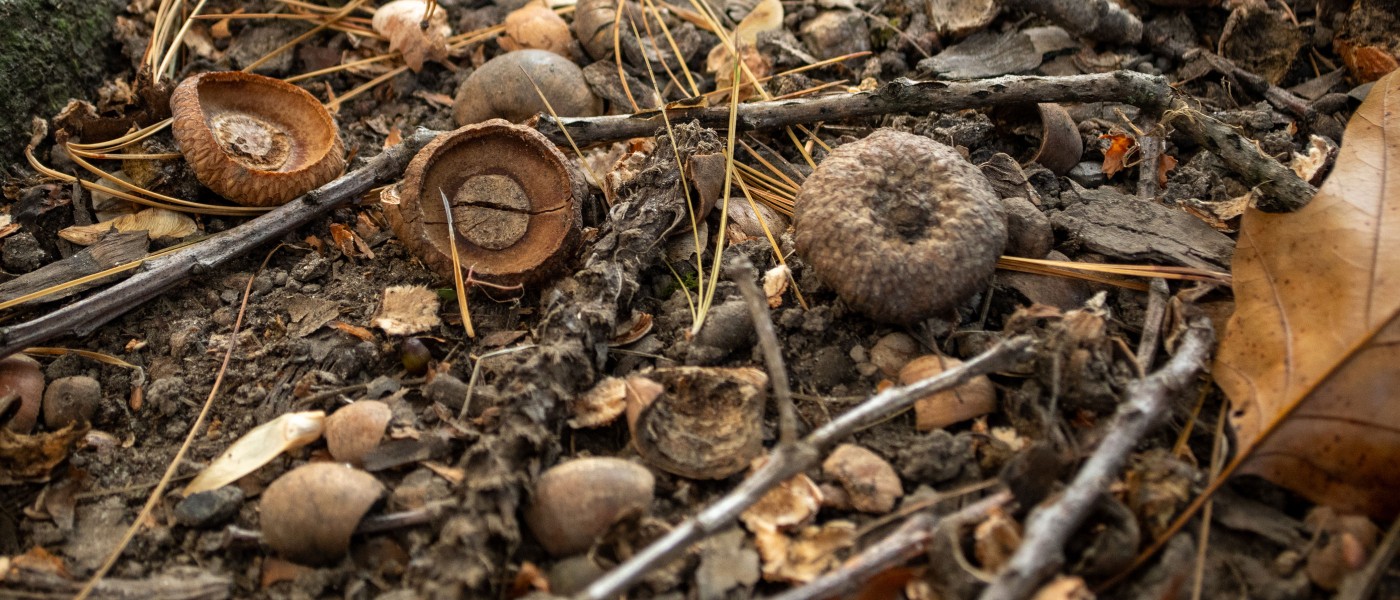The Lingering Mysteries of the Mast Year
Every few years, as if on cue, certain populations of trees drop unusually large quantities of acorns, walnuts, or other fruits, nuts, and seeds to the ground. This phenomenon is known as “masting,” or “mast seeding.” And scientists don’t know exactly why or how they do it.
Masting is, in short, the synchronized production of seeds by a population of plants. In other words, it’s a reproductive act that an entire population does together. Oak trees, for example, mast roughly every 2–5 years. Because populations can extend across vast swaths of the country, this can mean that a red oak tree on a street in Chicago is hurling acorns to the ground at around the same time as a red oak tree in the woods of New Hampshire.
This synchrony is of enduring interest to scientists, says Walt Koenig, emeritus research zoologist at UC Berkeley and a visiting fellow at the Cornell Lab of Ornithology. “It’s mysterious, perhaps almost unfathomable!”
Among the many mysteries of masting is what, precisely, qualifies as a “mast year.”
“Once you start quantifying it, it becomes really difficult to have a cutoff where you’re going to say, that’s a mast year, and that isn’t,” says Koenig. This is partly because there’s a lot of variability within populations—some trees never produce many seeds, so in a mast year they may only have a few acorns, even though that’s a huge investment for those individuals.
Broadly speaking, though, you’ll probably know it when you see it. (Or trip over it.)
“If you’re walking around outside and you see conifer trees covered in cones, or tons of acorns all over the ground, and you’re like, ‘Wow, that’s a lot’—that’s masting,” says Jalene LaMontagne, a population ecologist with expertise in mast seeding at DePaul University.
Back in August, New York City–based urban forester and Brooklyn Botanic Garden instructor Georgia Silvera Seamans noticed a “glut” of acorns around the city—particularly from red oaks like the northern red oak (Quercus rubra) and the pin oak (Quercus palustris).
Red oaks do seem to be experiencing a mast year across wide swathes of the continent, including in northern Illinois, Wisconsin, Ontario, and New Hampshire, LaMontagne reports. In Maryland, multiple species—from oaks to hickories and pawpaws—are reportedly experiencing a “very heavy” mast year.
“When we looked across the whole country, we saw clear evidence of high fruit production in a number of oak species,” says Theresa Crimmins, director of the USA National Phenology Network. A preliminary analysis of New York-specific data suggests that sugar maples, in particular, are having a big year here.
Though we often talk about masting as it relates to oaks and other wind-pollinated trees, certain grasses, shrubs, and other perennial plant species mast, too. And masting events can take place at different times of year (not just fall), depending on the species in question. This past spring, LaMontagne recalled, masting cottonwood trees around Chicago dropped so much fluff—each piece containing a seed—that it looked like it had snowed.
One of the most interesting things about masting is the powerful ecological ripples it can generate. “The world runs on acorns,” Koenig puts it.
He began studying masting because it affects the acorn woodpecker, who are highly dependent on acorn crops. One frequently cited study found that masting in oak forest ecosystems sets off a “chain of reactions,” impacting populations of mice and deer and chipmunks, which in turn affect populations of ground-nesting birds, invasive spongy moths, and ticks, the latter of which directly affects human health.
So, why does masting happen?
Researchers generally agree that environmental cues, like the weather, drive this synchronous behavior in some way. But other factors are likely afoot, too.
One potential evolutionary driver that’s often cited is the “predator satiation hypothesis.” The idea is that if perennial plants didn’t have this highly irregular reproductive schedule, and put out an average amount of cones or seeds every year, then populations of squirrels, birds, and other seed predators would increase up to the point where they’d eat all the seeds, and then stay there. Having periods of time where reproduction is low keeps the predator populations low, so that during these occasional deluges of seeds, there aren’t enough predators to eat them all.
Botanist and author Robin Wall Kimmerer, an enrolled member of Citizen Potawatomi Nation, writes vividly about these various hypotheses and the enduring lessons of masting in her bestselling book Braiding Sweetgrass (and this Orion essay).
Pecan hickory trees, and their irregular “pulses” of pecans, helped feed her ancestors in Oklahoma after they were forced at gunpoint from their homelands following the Indian Removal Act of 1830.
“If one tree fruits, they all fruit—there are no soloists,” Kimmerer writes.
“Not one tree in a grove, but the whole grove; not one grove in the forest, but every grove; all across the country and all across the state. The trees act not as individuals, but somehow as a collective. ... All flourishing is mutual.”


